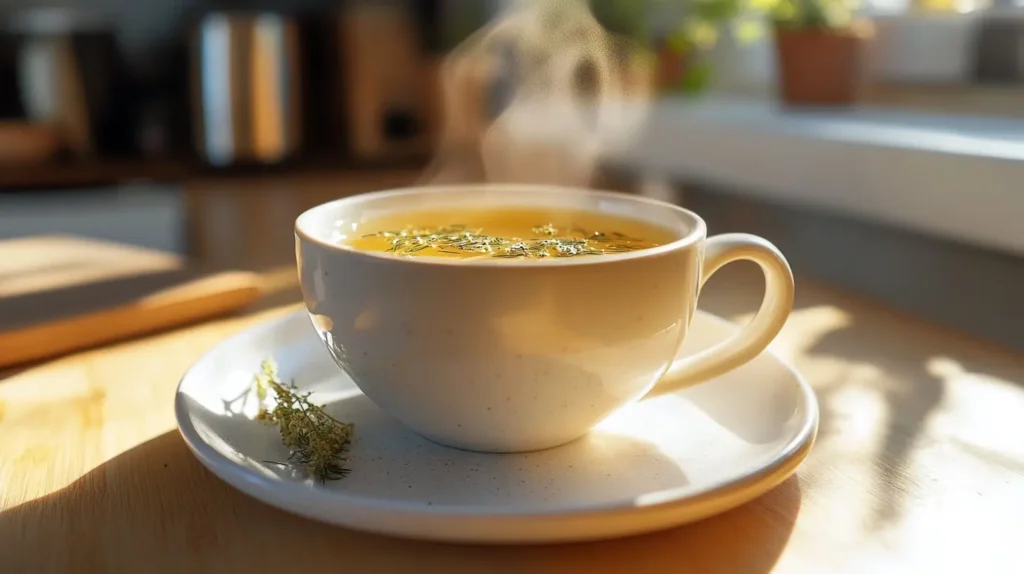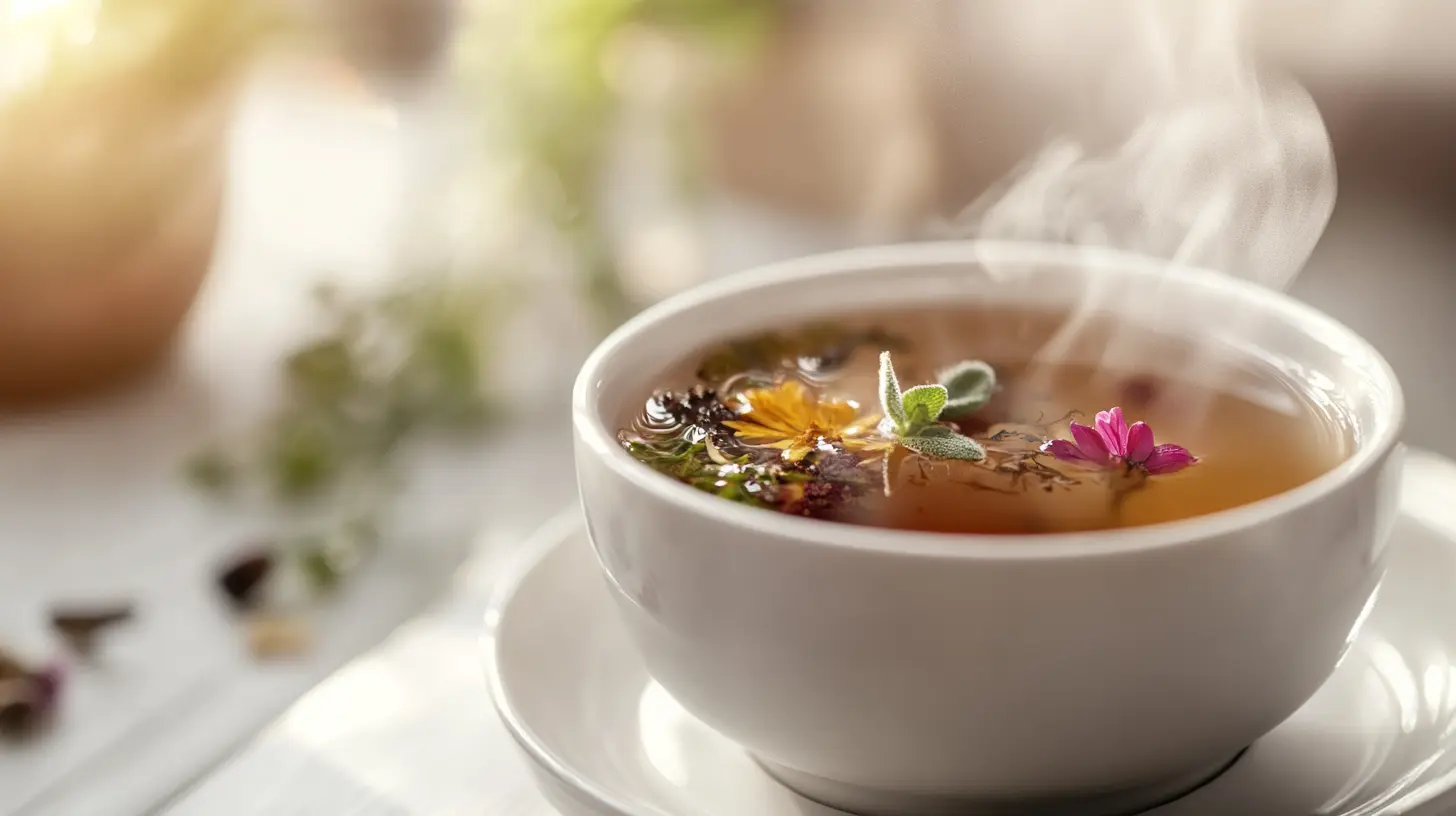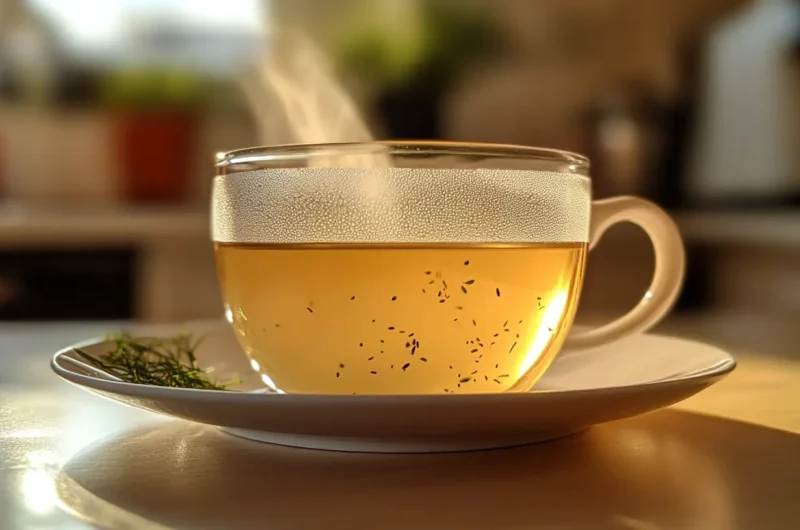There’s something deeply comforting about sipping a warm cup of herbal teas. Whether you’re winding down after a long day, soothing a sore throat, or simply enjoying a moment of stillness, herbal teas offer more than just flavor—they provide warmth, relaxation, and wellness in every sip. Packed with natural benefits, caffeine-free, and endlessly customizable, herbal teas have been cherished for centuries as both a comforting ritual and a health-boosting beverage.
Herbal Tea Recipe for Dinner
Course: DinnerCuisine: herbalDifficulty: Easy1
servings2
minutes10
minutes5 kcal (without sweeteners or add-ins)
kcalRight after dinner — perfect for aiding digestion and gently preparing your body for a restful evening.
Ingredients
1 tsp dried peppermint – eases digestion and bloating
½ tsp dried chamomile – promotes calm and reduces post-meal tension
½ tsp dried fennel seeds – supports digestive comfort
1 cup filtered water
Optional Add-ins:
1 tsp honey (for a mild sweetness and added soothing effect)
Small piece of fresh ginger (for warmth and extra digestive support)
Directions
- Boil the Water:
Bring 1 cup of water to a near boil (200°F / 93°C). - Steep the Herbs:
Add peppermint, chamomile, and fennel to a tea infuser or teapot.
Pour hot water over the herbs. Cover and steep for 7–10 minutes. - Strain and Serve:
Remove herbs. Add honey or ginger if using.
Sip slowly, ideally about 20–30 minutes after dinner.
Table of Contents
What Are Herbal Teas?
Unlike traditional teas made from the Camellia sinensis plant (such as black or green tea), herbal teas are infusions made from dried or fresh herbs, flowers, spices, and fruits. Also known as tisanes, they are naturally caffeine-free and bursting with flavors ranging from floral and earthy to spicy and fruity. Whether it’s chamomile for relaxation, peppermint for digestion, or hibiscus for a refreshing tartness, herbal teas cater to a variety of tastes and wellness needs.
The love for herbal teas spans cultures and centuries. Ancient Chinese, Egyptian, and Indian civilizations used herbal infusions not only as beverages but also as powerful remedies for healing the body and mind. From Ayurvedic tonics in India to chamomile teas in ancient Egypt, these brews have long been a cornerstone of traditional medicine and daily life.
Why Herbal Teas?
Herbal teas stand out because of their versatility and health benefits. They can be enjoyed hot or iced, blended to create unique flavors, and tailored for specific wellness goals—like boosting immunity, aiding sleep, or improving digestion. Whether you need an energizing morning brew, a calming nightcap, or a refreshing midday drink, there’s an herbal tea blend for every occasion.
For me, herbal teas are more than just a drink—they’re a cherished ritual. I still remember my grandmother brewing a pot of fresh mint tea from the garden, the soothing aroma filling the air. It was her way of offering comfort, warmth, and a gentle pause in the day. Now, every time I sip on a homemade herbal blend, it brings back those simple, grounding moments.
Types of Herbal Teas: Exploring Flavors & Benefits
Herbal teas come in a wide variety of flavors and benefits, making them a favorite choice for tea lovers worldwide. Whether you’re looking for a soothing bedtime brew or a revitalizing morning cup, there’s a perfect herbal tea for every moment. Let’s explore some of the most popular, unique, and seasonal blends!
Popular Herbal Teas
These classic herbal teas are well-loved for their distinctive flavors and health benefits:
- Chamomile – Known for its calming properties, chamomile has a mild, apple-like flavor and is perfect for relaxation and sleep.
- Peppermint – Refreshing and invigorating, peppermint tea is excellent for aiding digestion and relieving bloating.
- Ginger – Spicy, warming, and comforting, ginger tea is ideal for soothing nausea, improving circulation, and reducing inflammation.
- Hibiscus – A tart, vibrant tea rich in antioxidants and vitamin C, known for supporting heart health and offering a refreshing flavor.
- Rooibos – A naturally sweet, nutty tea from South Africa, packed with antioxidants and completely caffeine-free.
Lesser-Known Herbal Blends
Looking for something different? Try these unique herbal teas:
- Lemon Balm – Mild, citrusy, and known for reducing stress and promoting relaxation.
- Nettle – Earthy and nutrient-dense, nettle tea is high in vitamins and minerals, supporting overall wellness.
- Echinacea – Often used to boost the immune system and fight off colds.
Seasonal Herbal Tea Blends
Certain teas pair wonderfully with different times of the year:
- Summer: Cooling blends like mint, hibiscus, and citrus are refreshing and hydrating.
- Winter: Warming blends like ginger, cinnamon, and rooibos provide comfort and immunity support.
Tips for Choosing the Best Herbal Tea
- Use high-quality dried or fresh herbs for the best flavor and potency.
- Experiment with single herbs or create blends to customize your tea experience.
- Consider the health benefits—for example, peppermint for digestion, chamomile for sleep, and hibiscus for antioxidants.
No matter your preference, there’s an herbal tea for every taste and need. So go ahead, explore, and discover your new favorite blend!
How to Make Herbal Tea: A Step-by-Step Guide
Making herbal tea at home is simple, rewarding, and highly customizable. Whether you use fresh herbs from your garden or dried blends from your pantry, the process is easy and allows you to create a tea that suits your taste and wellness needs. Follow these steps to brew a perfect cup of herbal tea.
Step 1: Choose Your Herbs
The first step in making herbal tea is selecting the right herbs based on your flavor preference and health benefits. You can use a single herb or create a custom blend by mixing different herbs together.
Popular Herbal Choices:
- Relaxation & Sleep: Chamomile, lemon balm, lavender
- Digestive Support: Peppermint, ginger, fennel
- Immune Boosting: Echinacea, elderberry, thyme
- Antioxidant-Rich: Hibiscus, rooibos, rosehips
- Cooling & Refreshing: Mint, lemongrass, basil
Choosing Fresh vs. Dried Herbs:
- Fresh herbs provide a more delicate and vibrant flavor but require more herbs per serving.
- Dried herbs have a more concentrated taste, making them ideal for long-term storage.
Step 2: Prepare the Ingredients
Proper preparation ensures the best flavor and aroma in your tea.
- If using fresh herbs, rinse them thoroughly under running water to remove any dirt or debris. Chop larger leaves or flowers if needed.
- If using dried herbs, measure 1-2 teaspoons per cup of water. Some herbs, like hibiscus, have a stronger taste and may require less.
For stronger tea, increase the amount of herbs rather than extending the steeping time to avoid bitterness.
Step 3: Boil the Water
Water temperature plays a crucial role in extracting the best flavors from your herbs.
- Heat filtered or spring water to just below boiling, around 200°F (93°C).
- If boiling water, let it cool for 30-60 seconds before pouring over delicate herbs like chamomile or lemon balm to prevent scorching.
Avoid using microwaved water, as it can heat unevenly and affect the infusion process.
Step 4: Steep the Herbs
This step allows the flavors and beneficial compounds to infuse into the water.
- Place the herbs in a tea infuser, muslin bag, or directly into a teapot.
- Pour the hot water over the herbs, ensuring they are fully submerged.
- Cover the teapot or cup with a lid or small plate to trap the essential oils and prevent them from evaporating.
- Steep for 5-10 minutes, adjusting for herb type and strength preference:
- Light flavors (chamomile, lemon balm): 5-7 minutes
- Stronger herbs (ginger, hibiscus, rooibos): 8-10 minutes
For cold herbal tea, let the tea steep for a longer period (up to 30 minutes) at room temperature before refrigerating.
Step 5: Strain and Serve
Once the tea has steeped to your liking, strain it into a cup using a fine-mesh strainer, tea infuser, or muslin cloth.
Enhance Your Tea:
- Add honey or maple syrup for natural sweetness.
- Squeeze in lemon or orange juice for a citrusy boost.
- Stir in a splash of milk or dairy-free alternative for a creamy texture.
Herbal tea can be enjoyed hot or iced, making it a versatile drink for any season.
Pro Tips for the Perfect Cup
✅ Use a Tea Infuser or Muslin Bag – This makes straining easier and reduces herb residue in your tea.
✅ Adjust Steeping Times – Steeping too long can lead to bitterness, especially with strong-flavored herbs like hibiscus or rosemary.
✅ Store Herbs Properly – Keep dried herbs in an airtight container in a cool, dark place to preserve their flavor and potency for up to 6 months.
✅ Experiment with Blends – Try mixing different herbs to create unique flavors and enhance health benefits. For example:
- Peppermint + Lemon Balm → A refreshing, calming tea
- Ginger + Turmeric → A warming, anti-inflammatory blend
- Hibiscus + Rooibos → A tangy, antioxidant-rich brew
Enjoy Your Perfect Cup of Herbal Tea! 🍵
Making herbal tea is an easy, soothing ritual that allows you to experiment with flavors, health benefits, and presentation. Whether you’re sipping a hot cup for relaxation or enjoying a refreshing iced blend in summer, herbal tea is a delicious and nourishing addition to your daily routine.
Now, go ahead and brew your perfect cup! Let me know your favorite herbal tea blends in the comments.

Tips & Variations: Elevate Your Herbal Tea Experience
One of the greatest joys of making herbal tea is its customizability. From unique flavor infusions to stunning presentations, you can craft a tea experience that’s both delicious and visually appealing. Whether you’re adjusting for dietary preferences or creating special blends, these tips and variations will help you perfect your cup of herbal tea.
Flavor Variations: Get Creative with Ingredients
Herbal teas are incredibly versatile, allowing you to experiment with different flavors and additions:
- Citrus Infusion: Add fresh lemon, orange, or lime slices for a bright, zesty twist.
- Sweet & Soothing: Stir in a drizzle of honey, maple syrup, or agave nectar for a naturally sweet touch.
- Warm & Spiced: Enhance your tea with cinnamon sticks, cloves, or ginger for a cozy, aromatic depth.
- Herb Blends: Mix and match herbs like peppermint and chamomile for relaxation, or hibiscus and rosehips for a tangy, floral brew.
Dietary Adjustments: Make It Work for You
Herbal teas are naturally caffeine-free and easily adaptable to different dietary needs:
- Sugar-Free Option: Instead of sugar, try stevia, monk fruit, or a dash of vanilla extract for subtle sweetness.
- Caffeine-Free by Nature: Unlike traditional teas, herbal teas contain no caffeine, making them perfect for evening relaxation.
- Allergen-Friendly: If you’re sensitive to certain herbs, simply substitute with a different variety—for example, replace chamomile with lemon balm for a calming effect.
Presentation Ideas: Serve with Style
Enhance your herbal tea experience with thoughtful presentation:
- Use a Clear Glass Teapot – Show off the vibrant colors of ingredients like hibiscus, butterfly pea flower, or fruit slices.
- Garnish with Fresh Herbs & Flowers – A sprig of mint, a floating chamomile flower, or a cinnamon stick adds an elegant touch.
- Gift Your Own Tea Blends – Package dried herbal blends in decorative glass jars or kraft-paper pouches for a thoughtful homemade gift.
Enjoy the Perfect Cup, Your Way
Whether you’re sipping a calming chamomile blend before bed or enjoying a zesty hibiscus iced tea in the afternoon, herbal teas are as adaptable as they are delicious. Experiment with different ingredients, play with flavors, and make every cup uniquely yours!
Common Mistakes & How to Fix Them
Even though herbal teas are simple to prepare, small missteps can impact their flavor and quality. If your tea isn’t turning out as expected, don’t worry! Here are some common issues and easy solutions to help you brew the perfect cup every time.
Problem: The Tea Tastes Bitter
Solution: Herbal teas should be smooth and soothing, not overpowering or bitter. If your tea has an unpleasant bitterness:
- Reduce the steeping time – Some herbs, like chamomile and green herbs, release bitterness when steeped too long. Stick to 5-7 minutes for most teas.
- Use fewer herbs – Too many herbs in one batch can lead to an overly strong, astringent taste. Start with 1 teaspoon of dried herbs or 1 tablespoon of fresh herbs per cup and adjust as needed.
Problem: The Tea Is Too Weak
Solution: If your tea lacks flavor or feels watered down:
- Increase the amount of herbs – Some herbs, especially mild-flavored ones like lemon balm, may need a stronger concentration.
- Steep longer – Try 10-15 minutes for a stronger infusion, but avoid over-steeping delicate herbs.
Problem: The Herbs Lose Flavor Quickly
Solution: Herbs, especially dried ones, need proper storage to maintain their potency:
- Store in a cool, dark place – Keep dried herbs in an airtight container away from heat and sunlight.
- Use fresh herbs when possible – Fresh herbs have a more vibrant flavor and aroma compared to older, dried ones.
Problem: The Tea Is Too Hot or Too Cold
Solution: Temperature plays a key role in enjoying herbal tea at its best:
- If too hot, let it cool for a few minutes before drinking to prevent burning your tongue.
- If too cold, gently reheat on low heat instead of boiling to avoid altering the flavors.
Problem: The Tea Doesn’t Smell Fresh
Solution: Aroma is a big part of herbal tea enjoyment. If your tea lacks fragrance:
- Use fresh herbs whenever possible to enhance the natural scent.
- Check the expiration date of dried herbs—old or improperly stored herbs lose their aroma over time.
Perfecting Your Herbal Tea Routine
With these easy fixes, you can ensure your herbal tea is always flavorful, aromatic, and brewed just right. A few simple adjustments can make all the difference in your tea-drinking experience!
Health Benefits of Herbal Teas
Herbal teas are more than just a warm, comforting beverage—they’re packed with health benefits that support overall well-being. Made from nutrient-rich herbs, flowers, and spices, they offer natural remedies for digestion, immunity, sleep, and more. Here’s how different herbal teas can enhance your health.
Digestive Health: Soothe Your Stomach
Struggling with bloating or indigestion? Certain herbal teas help support digestion and ease discomfort:
- Peppermint Tea – Helps relax the digestive tract and relieve bloating.
- Ginger Tea – Stimulates digestion, reduces nausea, and soothes an upset stomach.
Relaxation & Sleep: Calm Your Mind
Some herbal teas have natural calming properties that help reduce stress and promote restful sleep:
- Chamomile Tea – A well-known sleep aid that relaxes the nervous system.
- Lemon Balm Tea – Reduces anxiety and improves sleep quality.
Immune Support: Strengthen Your Defenses
Herbal teas rich in antiviral and antibacterial properties can help boost immunity:
- Echinacea Tea – Supports immune function and may reduce the duration of colds.
- Elderberry Tea – Packed with antioxidants and vitamin C to fight off infections.
Antioxidant Properties: Protect Your Cells
Antioxidants help fight free radicals, reducing oxidative stress and supporting overall health:
- Hibiscus Tea – High in vitamin C and flavonoids, promoting heart health.
- Rooibos Tea – Rich in antioxidants that may improve skin and reduce inflammation.
Hydration: A Refreshing Way to Stay Hydrated
Unlike caffeinated drinks, herbal teas provide hydration without stimulants, making them a perfect alternative to coffee or soda.
Tips for Maximizing Health Benefits
- Drink herbal teas regularly as part of a balanced diet.
- Choose organic herbs to avoid pesticides and maximize health benefits.
- Customize blends to target specific health needs—for example, mixing ginger and lemon for immunity or peppermint and fennel for digestion.
By incorporating herbal teas into your daily routine, you can enjoy both their delicious flavors and powerful health benefits!
FAQs About Herbal Teas
Can I use fresh herbs instead of dried?
Fresh herbs offer a vibrant and natural flavor but contain more water than dried herbs, which can affect the recipe’s balance. When substituting fresh herbs for dried, use 2-3 times the amount to achieve a similar intensity. For example, if a recipe calls for 1 teaspoon of dried herbs, you should use 2-3 teaspoons of fresh herbs instead to maintain the intended flavor.
How long can I store herbal tea blends?
Properly stored herbal tea blends can retain their best flavor and potency for up to six months. To ensure freshness, keep them in an airtight container, such as a glass jar or resealable pouch, and store them in a cool, dark place away from sunlight and moisture. Avoid using plastic containers, as they may absorb essential oils from the herbs, potentially altering the tea’s aroma and taste.
Can I drink herbal tea every day?
Yes! Herbal teas are naturally caffeine-free and can be enjoyed daily, but it’s important to vary your blends to prevent overconsumption of any single herb. Certain herbs, like licorice root, should be consumed in moderation to avoid potential side effects. Additionally, always listen to your body—if you experience any sensitivities or reactions, adjust your intake accordingly to ensure a balanced and enjoyable tea-drinking experience.
What’s the best way to sweeten herbal tea?
The best sweeteners for herbal tea are natural and enhance the tea’s flavors without overpowering them. Honey adds a floral, soothing sweetness along with antibacterial properties, while maple syrup provides a mild caramel-like flavor. For those watching their sugar intake, stevia or monk fruit offer sugar-free alternatives without compromising sweetness. Additionally, fruit infusions, such as dried apples or berries, can naturally enhance the tea’s flavor without the need for added sugar.
Conclusion: Sip, Relax, and Enjoy the Magic of Herbal Teas
Herbal teas are a must-try for anyone seeking a natural, flavorful, and health-boosting beverage. Whether you want to unwind with chamomile, energize with peppermint, or boost your immunity with echinacea, there’s a perfect herbal blend for every occasion. These teas are not only versatile and caffeine-free but also packed with wellness benefits, making them a simple yet powerful addition to your daily routine.
Now It’s Your Turn!
I’d love to hear from you! Try making your own herbal tea blends, experiment with flavors, and share your results. What’s your go-to herbal tea for relaxation or health benefits? Do you have a special ingredient that makes your tea extra delicious? Drop your favorite herbal tea recipes or tips in the comments!
Keep Exploring!
If you enjoyed this guide, explore more about herbal remedies, tea rituals, and natural wellness tips to deepen your knowledge. Follow me on [Facebook] for more recipes, tea inspiration, and holistic living ideas.
No matter how you enjoy it, herbal tea is more than just a drink—it’s a ritual of self-care, comfort, and nourishment. So go ahead, brew a cup, take a deep breath, and savor the moment.
Enjoy your soothing cup of herbal tea!


